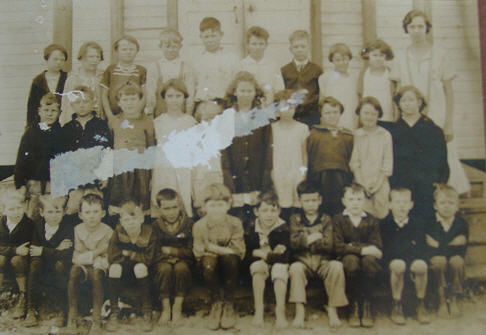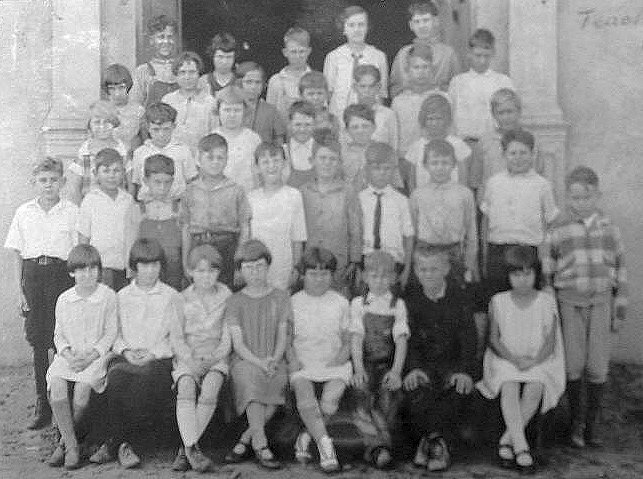HISTORY OF ZEPHYRHILLS HIGH SCHOOLThe Decade of 1920s at ZHS
Right after the Great War, the Roaring
20’s was a time of healing but also a time of prosperity and
optimism. ZHS seems to be in a very upbeat and progressive
timeframe as well. At the beginning of the decade, ZHS principal,
P.W. Corr, advertised in the local newspaper, the Zephyrhills Colonist,
for families to board local students, and this was a need with many
students still walking long distances to school. By the end of
the decade transportation was more available and more children were
able to attend school. The ZHS newsletter, known as the
“Zephyrhills High Weekly Spitwad,” reflected this optimism
in 1926 with giddy rhyming poems and satire about events at the
school. Publications in the local newspaper also included reports
on the whereabouts and activities of the students. An annual drama
production by ZHS continued to reflect humor and community fun, for
example, note 1928’s ZHS play, Crooks for a Month, 1927 play, For
the Love of Money, and Blundering Billy in 1921, presented
at the GAR Hall in Zephyrhills. When the new school was
constructed in 1926, there was a sense of real status as the plays were
now hosted for the community in the ZHS auditorium. The 1927 Miss
Zephyrhills was selected by repetitive votes by community members which
involved campaigns; the winner, Lucile Ryals received over 6,000 votes. The first ZHS PTA was formed by the ZHS
Principal M.P. Geiger in September 1926 with Lucious Sibley as the
first president. The PTA was very prominent throughout the decade in
hosting events at the school, coordinating homeroom mothers and
influencing decision-making at the school and building a sense of
cooperation between school and community. Regular inserts in
school informational articles in the local newspapers mentioned the
need for cooperation between teachers and parents. In the USA, the first transatlantic flight and the movie were celebrated. There must have been a similar sense of pride in innovation in Zephyrhills with the unveiling of their new ZHS building which was dedicated on September 10, 1926. A bond issue in June 1925, helped to raise funding for the new school. The News reflected on August 27, 1926 the level of pride in the community:
Even at the time of ZHS’s new school opening however, funding however, was a problem, The News reports in March 1927,
The opening of the new school brought several dedications and opening ceremonies. From a historian’s point-of-view the opening day of the 1926-27 school year although a time of great pride for the community with their brand-spanking new school building, was not a particularly proud time looking back. At the opening ceremony, a Bible was presented to the school by the ladies auxiliary of the local chapter of the Ku Klux Klan. The writer would urge readers to put this event in the context of the country at the time. In the US, immigration rose after World War I and so did nationalism. During the 1920s, the Ku Klux Klan revived itself nationally by promoting “100 percent Americanism,” gaining more than 4 million members and wielding significant influence in many states politically. Although the writer does not agree with the teachings of this notorious organization that brought so much brutality to American history, it would be inappropriate to sanitize the school’s history. In this collection, the writer has included an overview of what historical documentation exists of the African American School in Zephyrhills. The news article reporting the Bible gift at the opening is excerpted below:
There was a great deal of contradictions and cultural conflict. At the
conclusion of the decade, the Stock Market Crash of 1929 changed
lifestyles and accentuated needs. Health continued to be a
concern and the school provided a pivotal institution for disseminating
information. A health conference was hosted at ZHS on February
10, 1928 for all of the area mothers and young babies for the purpose
of weighing, measuring and providing some preventative
information. An account in 1927 reported that Dr. McGregor
visited ZHS to talk about health and diphtheria prevention to the
students. At ZHS, the mottoes of the graduation classes
provided some insight into the philosophical thinking which was rooted
in a strong work ethic. For example the class of 1928 had the
motto, “Onward Ever,” and 1926: “Labor has a sure
reward.” The newspaper accounts reported that the students hauled
clay for their baseball court in 1927. Sports during the decade
were primarily local events of contests between informal groups.
The weekly school events included a Chapel at the school.
Pageants and recitations were events at Thanksgiving and other holidays
at the school. It is noteworthy that the eighth grade
graduations were more involved and elegantly celebrated than the high
school graduation…simply because many students were still forced
to drop out of school to assume jobs in order to survive. A class
of 25 in grade 8 would sometimes dwindle to only 4 or 5 for high school
graduation. Note the 1928 graduation ceremony for grade 8 with
numerous parting songs and even a speech from a Professor of Philosophy
at University of Florida as the keynote speaker while in 1926, the
graduation featured Dr. H.S. Filmer of Brown University as keynote. The
smallest graduation class is seen during this decade for the class of
1925 with only one student, Julius Piller. Dropping out of school
was not seen as a shameful event in this time era, but one of necessity
and the school notes in the Zephyrhills News often list the students
who had left stating for example, in November 23, 1927, “we are
sorry to lose Rollin Plank and Raymond Kiddo from high school.” For those who did complete high school, the Junior-Senior Banquet at the Hotel Zephyr continued to be the event of the year. The April 8, 1927 account states,
The high school graduation was an occasion in rural Zephyrhills. This is before graduation robes and as the April 22, 1927 account details…
In sports, although there are numerous accounts of teams and competitions including Mr. Roberts’s team photo, Cecil McGavern—one that could compete officially in the state. The team composed of: John Loomis, Vernon Gall, Fred Gill, Julian Craig, Coach Major Reed, Charles Slater, Captain Louis Evans, Arthur Austin, John Pennington, Cecil McGavern and Owen Gall won every game that year (including a 32-2 victory over Dade City), losing that last State Tournament battle to St. Petersburg. In education the 1920’s were labeled the Progressive Movement with emphasis for the first time on the student point-of-view instead of solely from a dissemination of facts/authoritarian model. Leading the movement in the country was a former teacher, John Dewey. This philosophy was also reflected at ZHS. During the decade, the US was consumed by the Scopes Trail and Sacco-Vanzetti, and this is reflected in school archives and newspaper accounts and sometimes even parties that included debates between key students on a wide array of topics. It must have been challenging time for teachers in the midst of a philosophical shift as well. Pasco Superintendent O’Berry posted a notice in the local paper, warning teachers that they must be certified and should not apply for teaching jobs if they didn’t have a certificate. School board minutes post strict rules for teacher’s duties/responsibilities that included roles beyond the classroom. Minutes from September 5, 1921 say,
There’s no doubt, times were changing. Enjoy the newspaper accounts and other archives from the decade of the 1920’s….posted in order from most recent to earliest….1929-1920!

 |